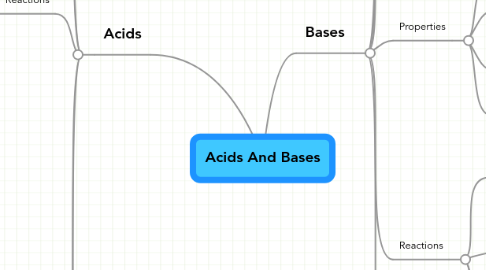
1. Acids
1.1. Definition
1.1.1. An acid is a substance that dissociates to form hydrogen ions when dissolved in water.
1.2. Classification
1.2.1. Organic acids contain carbon and are found in living things.
1.2.1.1. Lacitc Acid
1.2.1.2. Citric Acid
1.2.1.3. Ethanoic Acid
1.2.2. Inorganic acids do not contain carbon and are commonly found in science laborities.
1.2.2.1. Hydrochloric Acid
1.2.2.2. Sulfuric Acid
1.3. Reactions
1.3.1. Acids reacts with certain metals to form a salt and hydrogen gas
1.3.1.1. When a reactive metal, e.g. magnesium, is added to an inorganic acid like hydrochloric acid or sulfuric acid, effervescense will be observed.
1.3.1.2. The reactive metal will dissolve and the reaction will give out heat.
1.3.1.3. The bubbles of gas produced contain hydrogen gas.
1.3.1.4. Hydrogen gas can be tested by inserting a lighted splint into a test tube. If the gas is hydrogen, the splint will extinguish with a 'pop' sound.
1.3.1.5. Unreactive metals like copper and silver will not react with acids
1.3.2. Acids react with all carbonates to produce a salt, water and carbon dioxide gas.
1.3.2.1. When a carbonate compound, e.g. calcium carbonate, is added to an inorganic acid like hydrochloric acid or sulfuric acid, effervescence will be observed.
1.3.2.2. The bubbles of gas produced contain carbon dioxide gas.
1.3.2.3. Carbon dioxide can be tested for by bubbling the gas into calcium hydroxide solution, also known as limewater. If the gas is carbon dioxide, a white precipitate will be observed in the calcium hydroxide solution.
1.3.3. Acids react with metal oxides/hydroxides to give a salt and water
1.3.3.1. Types of oxides
1.3.3.1.1. Acidic Oxides
1.3.3.1.2. Basic Oxides
1.3.3.1.3. Amphoteric Oxides
1.3.3.1.4. Neutral Oxides
1.4. Properties
1.4.1. Acids taste sour.
1.4.2. Acids turn blue litmus red.
1.4.3. Acids are good electrolytes i.e. they are good conductors of electricity.
1.4.3.1. This is because the hydrogen ions are able to move about freely in the acid and thus can carry the electric charge
1.5. Applications
1.5.1. Hydrochloric Acid
1.5.1.1. Removes Rust
1.5.2. Sulfuric Acid
1.5.2.1. Used in car batteries
1.5.3. Nitric Acid
1.5.3.1. Making explosives
1.5.3.2. Fertilizers
2. Bases
2.1. Examples of bases
2.1.1. Sodium Oxide
2.1.2. Potassium Oxide
2.1.3. Magnesium Oxide
2.1.4. Sodium Hydroxide
2.1.5. Potassium Hydroxide
2.1.6. Magnesium Hydroxide
2.2. Definition
2.2.1. A base is defined as a substance that contains hydroxide ions (OHˉ) when dissolved in water.
2.2.2. A base can also be defined as a substance which accepts oxide or hydroxide ions.
2.3. Solubility
2.3.1. Bases have different solubility
2.3.2. Most are insoluble in water
2.3.2.1. Copper (II) Oxide
2.3.2.2. Lead (II) oxide
2.3.3. Bases which are soluble are called alkalis.
2.3.3.1. Sodium hydroxide
2.3.3.2. Calcium hydroxide
2.4. Properties
2.4.1. Alkalis have a bitter taste and soapy feel
2.4.2. Alkalis turn red litmus blue.
2.4.3. Alkalis only show their alkaline properties when dissolved in water
2.4.3.1. This is because it is the hydroxide ions that give alkalis its properties
2.4.4. Alkalis, like acids, are also good electrical conductors
2.5. Reactions
2.5.1. Neutralisation
2.5.1.1. Acid + Alkali => Salt + Water
2.5.1.2. E.g. Sodium Hydroxide + Sulfuric Acid =>Sodium Sulfate + Water
2.5.2. Alkali + Ammonium salt => Ammonia + Water + Salt
2.5.3. Example: Sodium hydroxide + Ammonium Chloride=> Sodium Chloride + water + Ammonia
2.5.3.1. Test for Ammonia gas: If a colourless, pungent gas that turns damp red litmus paper blue is produced, the gas is ammonia.
2.5.4. Alkali(of metal A) + salt(of metal B) => Metal B hydroxide + salt(of metal A)
2.5.4.1. Sodium hydroxide + Copper(II) sulfate=> sodium sulfate + Copper(II) hydroxide
2.5.4.1.1. If metal B hydroxide is soluble, reaction will not take place
2.6. Applications
2.6.1. Ammonia Solution
2.6.1.1. Window cleaning solutions
2.6.1.2. Fertilisers
2.6.2. Sodium Hydroxide
2.6.2.1. Soaps and Detergents
2.6.2.2. Industrial-cleaning detergents
2.6.3. Magnesium hydroxide
2.6.3.1. Toothpaste
2.6.3.2. Antacids
2.6.4. Calcium oxide
2.6.4.1. Neutralizing acidic soil
2.6.4.2. To make iron, concrete and cement
